Monofloral Honey: An In-Depth Analysis of Its Benefits
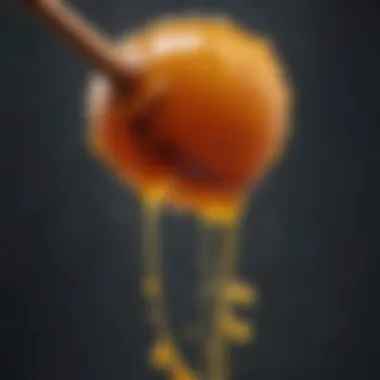
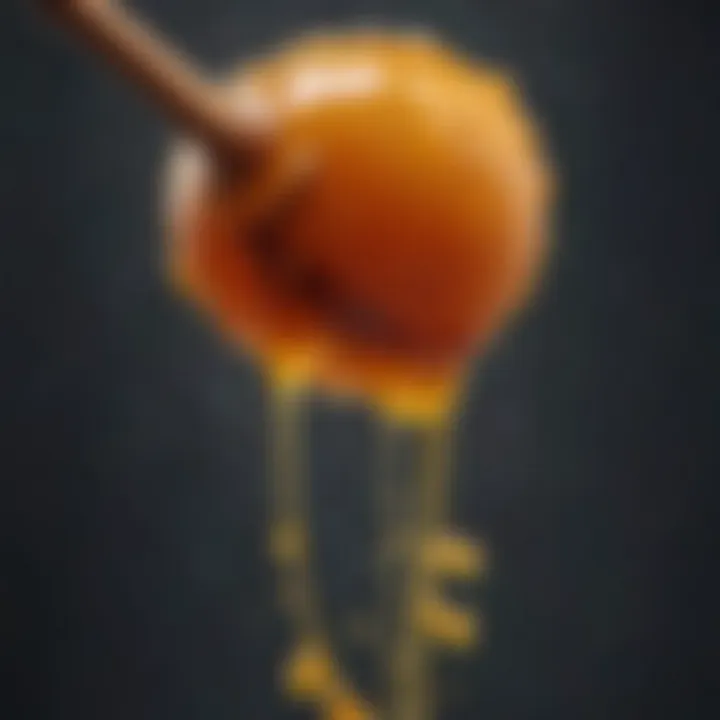
Intro
Monofloral honey is an intriguing topic that stands out in the realm of natural sweeteners. Unlike its multifloral counterparts, this type of honey is predominantly sourced from one specific plant species. This singularity in floral origin offers a unique taste, aroma, and potential health benefits. Each variety of monofloral honey captures not just the nectar but also the essence of its floral source, leading to distinct flavor profiles. This article aims to delve into the intricacies of monofloral honey, exploring its characteristics, production techniques, and significant health benefits.
Understanding the differences between monofloral and multifloral honey is essential, particularly for students, educators, and researchers interested in apiculture and nutrition. The carefully monitored production processes and the environmental factors influencing the quality of honey will be highlighted. Additionally, we will review various types of monofloral honey, their geographical importance, and explore potential applications in health and wellness.
This analysis will not only illuminate the physical attributes of monofloral honey but also the underlying methodologies that make them so special, providing a thorough understanding for those invested in the field.
Methodology
Overview of research methods used
To gain a comprehensive understanding of monofloral honey, a multifaceted approach to research is necessary. This includes a review of existing literature, laboratory analyses, and interviews with bee farmers and honey producers. Various scientific studies and publications provide valuable insights into the properties and benefits of different types of monofloral honey.
Data collection techniques
Data collection involved both qualitative and quantitative methods. Some of the techniques include:
- Literature Review: Gathering information from academic journals, books, and trusted websites like Wikipedia and Britannica to understand existing knowledge on monofloral honey.
- Laboratory Analysis: Assessing samples of monofloral honey for their nutritional content, antioxidant levels, and other relevant components.
- Interviews: Conducting discussions with practitioners in the field, including apiarists and health professionals, to gather experiential data on the benefits and uses of monofloral honey.
"The richness of monofloral honey lies not only in its flavor but also in its potential health properties, which can vary significantly based on the floral source."
Future Directions
Upcoming trends in research
Research on monofloral honey is evolving continuously. One trend is a growing interest in its medicinal properties. Studies are increasingly examining how various types of honey can contribute to health improvements and disease prevention. Researchers are also focusing on the effects of climate change on honey production and how this impacts the availability of florals used in monofloral honey.
Areas requiring further investigation
Despite extensive research, there are still numerous areas needing exploration, including:
- Geographic Variation: Understanding how different regions influence the characteristics of monofloral honey.
- Therapeutic Applications: More studies are needed to confirm the health benefits associated with each type of monofloral honey.
- Market Dynamics: Analyzing consumer behavior in relation to the growing demand for monofloral honey in health-oriented markets.
In summary, this article will serve as a gateway into the world of monofloral honey, providing rich information on its production, qualities, and the scientific inquiry that surrounds it.
Prelims to Monofloral Honey
Monofloral honey refers to honey primarily sourced from one type of flower. Its importance lies in the distinct flavor and nutritional profiles that arise from the single-source nectar. This article explores these qualities, elucidating various types of monofloral honey and their significance in both culinary applications and health benefits. The emphasis is placed on understanding how specific flowers influence honey composition, which can appeal to connoisseurs and health-conscious individuals alike.
Definition and Characteristics
Monofloral honey is characterized by its dominant floral source, which accounts for a significant portion of the nectar collected by bees. Unlike multifloral honey, where nectar comes from various blooms, monofloral honey often exhibits flavor notes, aroma, and color that correspond directly with its floral source.
For example, Manuka honey, derived from the Leptospermum scoparium plant, offers a distinct earthy taste and is known for its medicinal properties. On the other hand, lavender honey possesses a light floral flavor and is often used in gourmet dishes.
Due to these distinctive characteristics, monofloral varieties are sought after for specific culinary uses, as well as for their unique health benefits. Moreover, the environment, including soil and climate, can further influence the properties of the honey, making each batch unique.
Historical Perspective
The production of honey dates back thousands of years. Ancient civilizations, including the Egyptians and Greeks, recognized the value of honey, particularly monofloral varieties. In fact, honey was used not just as a food source but also in religious rituals and medicinal practices.
Historically, trade routes in regions like the Mediterranean facilitated the exchange of specific types of honey, which were prized for their distinct qualities. The documentation of these varieties highlights the longstanding appreciation for monofloral honey across cultures.
Today, the interest in these products has surged, driven by consumer awareness regarding health benefits and flavor profiles. The rich history and cultural significance of monofloral honey continue to motivate research and production, helping to sustain this ancient practice in modern society.
"Monofloral honey invites us into the world of flavors and health benefits, rooted deep in history and culture."
Types of Monofloral Honey
When exploring monofloral honey, it is vital to understand the specific types available. Each type is derived from the nectar of distinct flowers, reflecting unique characteristics, flavors, and potential health benefits. The diversity in monofloral honey types contributes significantly to its appeal, not only in culinary contexts but also in health and wellness applications.
Clover Honey
Clover honey is perhaps one of the most recognized types of monofloral honey. It is primarily sourced from clover plants, which flourish in various geographical regions, especially in North America. The honey has a light color and mild flavor, often described as sweet with floral undertones. The production of clover honey is common due to the widespread growth of clover, making it an accessible source for beekeepers. This makes it popular in many households. In addition to being a sweetener, clover honey contains antioxidants and can aid digestion. Its versatility in both culinary uses and health applications makes it a favored choice among consumers.
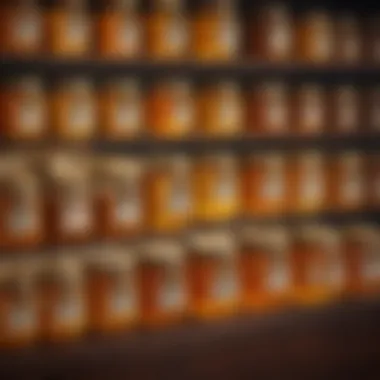
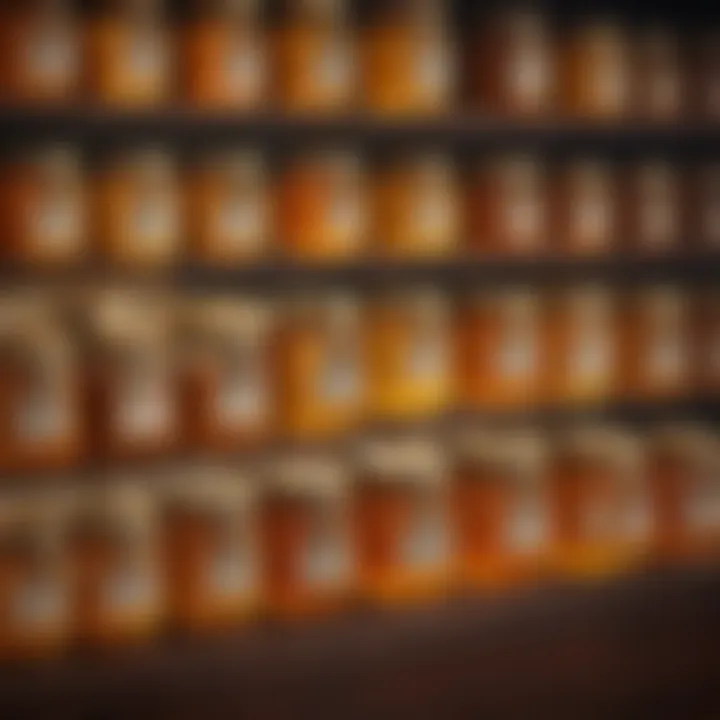
Manuka Honey
Manuka honey, which originates from the nectar of the Manuka tree in New Zealand and parts of Australia, is celebrated for its unique antibacterial properties. It has a distinct, somewhat earthy taste that differentiates it from other types. Manuka honey is often marketed for its health benefits, particularly in wound care and immune support. The presence of the compound methylglyoxal is what sets it apart and contributes to its medicinal reputation. Marketers utilize its health claims extensively, leading to a premium price on the market. Beekeepers must ensure the honey meets specific UMF (Unique Manuka Factor) standards to authenticate its quality.
Thyme Honey
Thyme honey is sourced predominantly from the nectar of thyme plants. It possesses a strong, aromatic flavor with herbal notes. Often produced in Mediterranean regions, thyme honey is favored for its potential antimicrobial and anti-inflammatory properties. It is rich in flavonoids and other antioxidants. These elements add to its popularity not only as a sweetener but also as an additive in herbal remedies. Its usage in culinary applications also brings a distinctive taste, making it a sought after ingredient by chefs and home cooks alike.
Lavender Honey
Lavender honey is made primarily from the nectar of lavender flowers. This type of honey is easily identifiable by its floral aroma and a light, sweet flavor profile. The unique flavor of lavender honey makes it ideal for culinary uses, especially in baking and desserts. Additionally, lavender honey is often used for its calming properties and is believed to promote relaxation and sleep. Its popularity in wellness products is a testament to its dual role as both a culinary delight and a natural remedy. Many consumers prefer lavender honey for its distinctive taste and potential therapeutic benefits.
Heather Honey
Heather honey is known for its complex flavors and darker color, sourced from heather blooms. This type of honey is primarily produced in regions with prominent heather growth, such as Scotland and parts of Northern Europe. Heather honey contains a higher concentration of minerals, which contributes to its robust flavor and sticky consistency. The honey is often characterized by its rich and aromatic taste, making it a favorite amongst those who enjoy stronger flavors. Additionally, it is renowned for potential health benefits, particularly in supporting digestive health due to its high nutrient content.
Production of Monofloral Honey
The production of monofloral honey is a complex and multifaceted process that plays a crucial role in defining its quality and characteristics. Understanding the various factors involved in this production helps in appreciating the unique properties of monofloral honey. The methods used in beekeeping, the sources of nectar, and the harvesting techniques significantly influence the final product. These aspects not only determine the flavor and aroma but also impact the honey's health benefits, making this section particularly relevant to the overall analysis.
Beekeeping Practices
Beekeeping practices are fundamental to the production of high-quality monofloral honey. Beekeepers must provide suitable environments for their bees, ensuring that they flourish and remain healthy. This involves selecting appropriate hive types and managing bee populations effectively. Moreover, understanding bee behavior is vital for optimizing honey production.
The timing of hive placement is also essential. For instance, hives must be placed near areas abundant in the specific flowers from which the honey is to be harvested. This helps bees collect nectar efficiently, leading to higher yields. Practices such as organic beekeeping can enhance honey quality by minimizing exposure to chemicals, thereby ensuring a pure final product.
Nectar Sources
The nectar sources for monofloral honey are quite specific, as the honey is predominantly derived from one type of flower. Each type of flower contributes distinct flavors and characteristics to the honey. Monitoring flower blooming times is essential since bees can only produce monofloral honey when the desired flower is in bloom. In regions where multiple flowering plants coexist, it is necessary for beekeepers to isolate the hives to achieve true monofloral honey.
Additionally, not all nectar sources are equal. Factors like the soil quality, climate conditions, and biodiversity all play a role in nectar production. For instance, Manuka honey, derived from the Manuka tree in New Zealand, possesses unique properties attributed to its distinct nectar composition.
Harvesting Techniques
Harvesting techniques are equally important in the production of monofloral honey. The timing of harvest can greatly affect the honey's quality. Beekeepers need to wait until the honey is capped, which indicates that it has been thoroughly processed by the bees and is ready for collection. Careful handling during extraction is also critical; heat should be avoided as it can destroy the delicate enzymes and nutrients inherent in the honey.
Two common techniques are centrifugal extraction and crush-and-strain methods. Centrifugal extraction involves using a honey extractor that spins the frames to force honey out. This method is efficient and preserves the quality of the honey. The crush-and-strain method, while more labor-intensive, allows for a gentler extraction, often favored in artisanal honey production.
Adopting proper practices in these areas not only enhances the honey's quality but also its marketability. Careful attention to the details during production can yield honey that stands out both in flavor and health benefits.
Overall, understanding the nuances of production helps appreciate the uniqueness of monofloral honey.
By focusing on the specific beekeeping practices, nectar sources, and harvesting techniques, we can gain deeper insight into how these elements contribute to the distinct characteristics of monofloral honey.
Geographical Significance
The geographical significance of monofloral honey extends beyond mere location; it plays a critical role in determining the unique characteristics and benefits of this type of honey. The region where the bees collect nectar not only influences the flavor but also impacts the nutritional profile and medicinal properties of the honey.
Understanding regional varieties is essential, as different areas cultivate various floral species that provide bees with distinct nectar sources. For example, thyme honey from Greece showcases the aromatic qualities of the local thyme plant, while Manuka honey, harvested in New Zealand, is renowned for its high antibacterial properties derived from the Leptospermum scoparium flower. Each region contributes to a diverse array of monofloral honeys, making them unique in taste and potential health benefits.
Additionally, the climate influence cannot be overlooked. Different weather patterns and environmental factors shape the blooming periods of specific flowers. Bees can only gather nectar when flowers are in bloom, meaning the local climate directly affects honey production levels. In some regions, a dry season may limit flowering, resulting in a lower production of honey. Conversely, in areas with ample rainfall, nectar sources may flourish, leading to a more robust honey yield.
The geographical specifics of monofloral honey are pivotal for researchers, as they provide insight into the relationship between local flora and the quality of honey produced.
These geographical considerations not only enrich the experience of consuming monofloral honey but also enhance its appeal in culinary applications and health remedies. Understanding these factors is crucial for consumers, as they seek the best products tailored to their preferences and nutritional needs.
Chemical Composition
Understanding the chemical composition of monofloral honey is vital for appreciating its unique properties and benefits. This section will delve into the specific elements that contribute to the flavor, nutritional value, and health advantages of various types of monofloral honey. Its composition can vary significantly depending on the flower source, affecting both taste and therapeutic applications. This information is important for consumers, researchers, and health professionals seeking to utilize honey in different contexts.
Sugars and Nutrients
Monofloral honey is primarily composed of sugars, which constitute about 80% of its content. The primary sugars include fructose and glucose. Fructose is especially notable for its high sweetness level and its ability to remain stable during prolonged storage. Meanwhile, glucose crystallizes faster; this can lead to a different texture in honey, a characteristic often seen in crystallized varieties.
In addition to sugars, monofloral honey contains essential nutrients such as vitamins, minerals, and amino acids. These components vary according to the floral source. For instance, Manuka honey from the Leptospermum tree has a distinct profile rich in methylglyoxal, known for its unique health benefits.
Some key nutritional elements found in monofloral honey are:


- Vitamin C: Antioxidant that supports the immune system.
- B vitamins: Important for cellular metabolism.
- Minerals like potassium, calcium, and magnesium help with various physiological processes.
By analyzing the sugars and nutrients, we can better understand both the taste and the health benefits associated with consuming different varieties of monofloral honey.
Presence of Enzymes
The presence of enzymes in monofloral honey plays a crucial role in its preservation and health benefits. These enzymes, primarily derived from the bees, catalyze certain reactions that enhance the honey's properties. One of the key enzymes found in honey is invertase, which helps convert sucrose into glucose and fructose, thus contributing to the honey's sweetness and stability.
Another important enzyme is diastase, which breaks down starches into sugars. This enzyme showcases honey's potential as a digestible energy source. Additionally, the enzyme glucose oxidase is responsible for producing hydrogen peroxide, which gives honey its antimicrobial properties.
The activity levels of these enzymes can vary based on several factors, including the floral source, the processing methods, and storage conditions. Raw, unfiltered monofloral honey tends to retain higher enzyme activity compared to processed varieties. This retention offers greater health benefits and more robust flavor profiles.
The enzymatic activity in honey not only contributes to its taste and flavor but also enhances several medicinal qualities, making it a popular choice among health enthusiasts and professionals.
In summary, understanding the chemical composition of monofloral honey, particularly its sugars, nutrients, and enzymes, provides comprehensive insight into why this natural product holds such a prominent place in nutrition and health.
Health Benefits of Monofloral Honey
Monofloral honey is not just a sweetener; it holds numerous health benefits that can contribute significantly to overall well-being. Understanding these benefits is essential for those who seek to incorporate this natural product into their diet. Each type of monofloral honey offers unique properties attributed to the specific flower from which the nectar is harvested. This section explores three main health benefits: antioxidant properties, antimicrobial effects, and digestive health.
Antioxidant Properties
Antioxidants are compounds that prevent oxidation, a chemical reaction that can produce free radicals leading to cell damage. Monofloral honey is rich in antioxidants, which can provide various health benefits. Studies have shown that honey varieties, like Manuka honey, contain a higher concentration of antioxidants compared to others. The antioxidants in monofloral honey may help combat oxidative stress and reduce the risk of chronic diseases such as heart disease and cancer.
- Flavonoids: These compounds are particularly important for their antioxidant properties, helping to neutralize harmful free radicals in the body.
- Phenolic Acids: Present in certain types of honey, these acids also contribute to improved health by mitigating oxidative stress.
Incorporating monofloral honey into your diet may therefore offer a natural way to boost your antioxidant intake, contributing to better health outcomes.
Antimicrobial Effects
Monofloral honey has been documented for its antimicrobial properties, which are especially notable in varieties like Manuka honey. This type of honey is renowned for its ability to inhibit the growth of various pathogens. Research indicates that honey’s acidity and the presence of hydrogen peroxide enhance its antimicrobial abilities.
- Bacterial Inhibition: Honey can slow the growth of bacteria, making it useful in treating minor wounds and burns.
- Yeast and Fungi: Some studies have shown that certain monofloral honeys can also combat yeast and fungal infections.
These effects underline the potential of monofloral honey as a natural option for supporting the immune system and treating infections, thus emphasizing its value beyond culinary uses.
Digestive Health
The consumption of monofloral honey may also benefit digestive health. Studies have indicated that it can be gentle on the digestive tract, easing symptoms of issues like gastritis and diarrhea. Honey is known to have prebiotic properties; it stimulates the growth of beneficial gut bacteria, thereby supporting a healthy digestive system.
- Soothing Properties: Its natural soothing effects can provide relief for sore throats and gastrointestinal discomfort.
- Gut Flora Support: By promoting the growth of good bacteria, monofloral honey can contribute to improved digestion and overall gut health.
Regulatory Standards
Understanding regulatory standards is crucial in the context of monofloral honey. These standards help ensure product quality, safety, and authenticity. They serve both producers and consumers, establishing guidelines that govern everything from production practices to labeling requirements. Regulatory bodies set these standards to protect consumers from adulterated products and to ensure that what is sold as monofloral honey truly meets certain criteria.
Quality Control Measures
Quality control measures are fundamental in the production of monofloral honey. They ensure that honey maintains its unique characteristics while also being safe for consumption. Common practices include regular testing for purity and contaminants. These tests often assess factors such as moisture content, the presence of foreign sugars, and even the floral source of the nectar used. Various countries have different benchmarks for these checks, influenced by local regulations and customer expectations.
For instance, many producers utilize spectrometry to verify the floral origin of the honey. This technology helps confirm that the product is indeed monofloral, as inaccurately labeled honey can mislead consumers. Additionally, beekeepers may implement routine hive inspections to monitor bee health, which directly impacts honey quality. By establishing rigorous quality control measures, producers can reassure consumers of the authenticity and safety of their honey products.
Labeling and Certification
Labeling of monofloral honey must meet specific legal guidelines. Proper labeling provides essential information about the product's origins, the floral source, and any certifications it may have. For example, honey that is certified organic often commands a higher market price. Labeling thus serves not just as a means of consumer information, but also as a marketing tool that confirms product quality and value.
Certifications are another important aspect. Organizations such as the International Honey Commission and various local bodies set protocols for certification that can affect a product's reach in the market. Certified honey may go through stringent testing processes that examine not only its purity but also its compliance with international standards for food safety.
Moreover, the presence of certifications on labels enhances consumer trust. Shoppers looking for genuine monofloral honey can make informed choices based on accurate information. When consumers know they are purchasing a product that meets established standards, it increases their overall satisfaction, potentially leading to repeated purchases.
"Regulatory standards ensure the safety and authenticity of monofloral honey, providing essential protection for consumers and producers alike."
Keeping regulatory standards under review is essential as market demands change and environmental factors evolve. Stakeholders in the honey industry must stay informed about these standards to remain compliant and competitive in a growing market.
Culinary Use of Monofloral Honey
The culinary application of monofloral honey transcends simple flavor enhancement. It plays a notable role in various gastronomic practices, providing not only distinct tastes but also health attributes that complement recipes. Each type of monofloral honey carries its unique flavor profile, which can elevate the overall dish while also offering nutritional benefits.
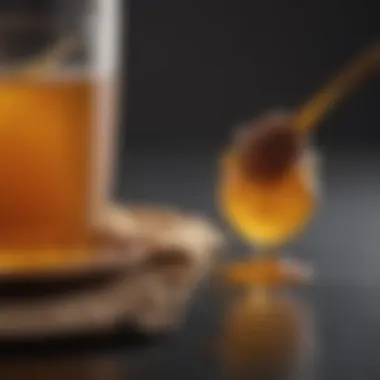
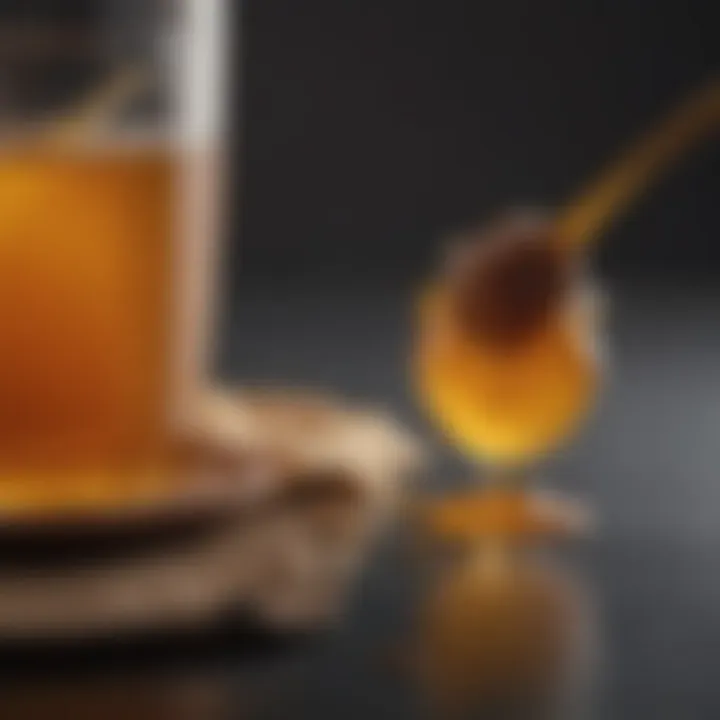
Flavor Pairings
When considering monofloral honey in culinary contexts, understanding its flavor pairings is essential. Each type of honey pairs well with specific ingredients, enhancing both taste and health benefits. For example:
- Manuka Honey: Its rich, robust flavor stands up well to hearty dishes. It complements grilled meats and can be drizzled over roasted vegetables.
- Lavender Honey: This has a floral note that matches well with baked goods. It can be incorporated into cakes or used in tea.
- Thyme Honey: Its herbal profile makes it excellent for savory dishes. It works well in marinades or salad dressings.
- Heather Honey: Its strong, earthy taste pairs nicely with cheeses, offering a unique contrast.
These pairings highlight the versatility of monofloral honey in various culinary applications, from appetizers to desserts.
In Recipes
Using monofloral honey in recipes offers an avenue for not only flavor but also health benefits. Here are some considerations:
- Salad Dressings: Monofloral honey can serve as a natural sweetener in vinaigrettes. For instance, mixing thyme honey with olive oil and vinegar creates a balanced dressing.
- Baking: Honey provides moisture and sweetness. Replacing sugar with clover honey in baked goods maintains texture while adding unique flavor.
- Marinades: Combining honey with vinegar, soy sauce, and spices creates a complex marinade. Manuka honey, due to its antimicrobial properties, can slightly enhance food preservation during marination.
- Tea and Beverages: Simply stirring a spoonful of lavender honey into herbal tea can create a soothing effect, showcasing the honey’s natural flavor and health benefits.
Market Trends
The dynamics surrounding monofloral honey are rapidly evolving. This section examines the significance of market trends in the industry, shedding light on various elements that influence its growth and consumption. Understanding these trends helps businesses adapt to consumer demands and fosters sustainability within the sector. Moreover, these insights can guide researchers and educators in grasping the nuances of this specialty product.
Consumer Preferences
Consumer preferences play a crucial role in shaping the market for monofloral honey. A growing number of consumers prioritize natural and organic food products, seeking quality over quantity. This shift reflects a broader trend towards health-conscious choices, where individuals are more informed about nutrition.
Some specific factors influencing consumer preferences include:
- Flavors and Aroma: Unique flavor profiles such as those found in Manuka or Lavender honeys attract discerning palates.
- Health Benefits: With increased awareness of the health benefits of monofloral honey, consumers are drawn to varieties that offer specific nutritional advantages, such as antioxidant properties in Thyme honey.
- Sustainability: Environmentally-conscious consumers prefer brands that demonstrate sustainable beekeeping practices and transparent sourcing.
Understanding these preferences not only helps producers tailor their offerings but also enhances marketing strategies to capture the attention of potential buyers.
Emerging Markets
Emerging markets represent a significant opportunity for growth in the monofloral honey sector. Countries in Asia, Africa, and Latin America are beginning to recognize the value of honey, and interest in monofloral varieties is increasing.
Key aspects of these emerging markets include:
- Rising Middle Class: As economies develop, a rising middle class with disposable income is eager to explore premium food products, including specialty honey.
- Export Opportunities: Regions known for their unique floral sources, such as New Zealand for Manuka, have the potential to expand their reach through international trade.
- Cultural Significance: In many cultures, honey holds historical and health-related importance, making it more appealing in domestic markets.
The combination of these factors indicates a vibrant future for monofloral honey. Producers and stakeholders must remain vigilant, adapting to the specific needs and tastes of these markets while maintaining product integrity and quality.
"The evolving landscape of consumer preferences and expanding markets indicates a promising future for monofloral honey, driven by informed choices and cultural connections."
As the market continues to shift, both producers and researchers can benefit from understanding these trends and their underlying factors.
Challenges Facing the Industry
The production of monofloral honey is increasingly facing significant challenges that impact its availability and quality. Understanding these challenges is crucial for those involved in beekeeping, agriculture, and health sectors. Both environmental impacts and market saturation hold major implications for the future of monofloral honey.
Environmental Impacts
Environmental changes are one of the most pressing issues affecting the honey industry. Factors like climate change, pesticide use, and habitat loss create serious threats to bee populations. Bees are essential for pollinating the flowers from which monofloral honey is derived.
- Climate Change: Changes in temperature and precipitation patterns can alter the blooming times of flowers, leading to mismatched timings between bee activity and nectar availability. This can hinder honey production, especially for specific varieties.
- Pesticides: The widespread use of pesticides in agriculture can have detrimental effects on bee health. Toxic chemicals can weaken bee colonies, reduce their populations, and affect their ability to forage. As a result, less nectar is collected, impacting the yield of monofloral honey.
- Loss of Biodiversity: Urbanization and industrialization lead to the loss of flowering plants that provide nectar sources to bees. This loss can reduce the diversity of available monofloral honey types.
"Without a healthy ecosystem, the future of honey production, especially monofloral varieties, remains uncertain."
Market Saturation
The honey market is experiencing saturation, with many brands and producers entering the space. This presents both opportunities and challenges. While increased competition can benefit consumers through lower prices, it can put pressure on producers,
- Quality vs. Quantity: Some producers may prioritize quantity over quality to compete. This can lead to adulteration and a dilution of the unique flavors and properties associated with authentic monofloral honey.
- Overproduction: With many players in the market, there is a risk of overproduction. This can lead to an oversupply, reducing prices and making it challenging for smaller producers to sustain their businesses.
- Consumer Awareness: As the market becomes crowded, informing consumers about the unique benefits of specific monofloral honeys becomes increasingly difficult. This can affect sales and market growth, particularly for higher-end, specialized products.
Navigating these challenges requires concerted efforts from producers, regulators, and consumers. Addressing environmental concerns and ensuring quality in a saturated market are vital for the continued success of the monofloral honey industry.
Closure
The conclusion of this article underscores the significance of monofloral honey in various dimensions, from its unique qualities to its health benefits and implications for industry and environment. Monofloral honey, as defined in earlier sections, stems from the nectar of a single type of flower, granting it distinct flavors and characteristics that set it apart from multifloral varieties.
Understanding these distinctions is crucial for consumers and producers alike. The flavor profiles can enhance culinary experiences, while the health benefits, such as antioxidant properties and antimicrobial effects, make it a valued addition to diets. Knowledge of these aspects allows consumers to make informed choices regarding their honey purchases.
Another vital element highlighted in this article is the regulatory standards guiding the honey industry. Quality control ensures that monofloral honey maintains its integrity and authenticity. This is particularly important in markets where consumers demand transparency and quality assurance.
Furthermore, the challenges facing the honey industry, like environmental impacts and market saturation, should inform stakeholders about the pressing issues needing attention. Addressing these problems will not only enhance production practices but also foster sustainability.
In summary, the synthesis of the information presented reveals that monofloral honey is more than a sweet substance; it encapsulates a blend of health, flavor, and economic significance. The careful consideration of its production, health benefits, and market dynamics contributes to a deeper appreciation of this unique natural product. As consumers and producers engage with this knowledge, they advocate for better practices and standards in the honey industry.







